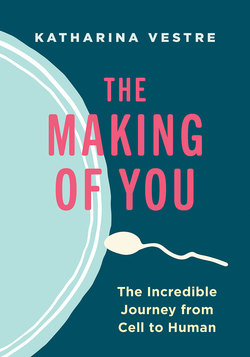Читать книгу The Making of You - Katharina Vestre - Страница 13
На сайте Литреса книга снята с продажи.
ОглавлениеTHE FIRST FEW hours. The race is over, and your very first cell floats calmly down the fallopian tube. So much has already been decided. Even though the cell is tinier than the full stop at the end of this sentence, it is large enough to contain all the instructions needed to build you, from the organs that will keep you alive to your eye colour and the shape of your nose.
Leeuwenhoek never managed to discover it, but the cell’s great secret was not a miniature person. It was a molecule. And the story of this molecule begins with pus.
In 1869 a Swiss chemist named Friedrich Miescher contacted a surgical clinic near his laboratory. ‘Would you let me have some used bandages from your patients?’ he asked. ‘Preferably covered in as much pus as possible.’ Miescher was looking for white blood cells, something there were masses of in the whitish-yellow gloop that oozes from sores. White blood cells are the remnants of a battlefield – they work for the immune defences – and many of them give their lives in the war against bacteria that is fought in wounds. Miescher collected the pus, filtered out the cells and conducted a thorough chemical analysis to examine the types of proteins they contained. During one experiment he noticed a sticky, milk-white substance that separated from the rest of the mixture when he added acid. Upon further examination, Miescher realised that it couldn’t be a protein. He called the new substance nuclein, since it sat at the cell’s core, the nucleus. Miescher found that there was an unusually large amount of nuclein in sperm cells, and realised that this substance must play a crucial role at the start of life.
Back then, genetics was still a mystery, driven by invisible forces that no one understood. The idea that hereditary material was actually a specific molecule – one that could be weighed and measured – was inconceivable for most people. But Miescher himself was an avid proponent of this theory. He suggested that the information contained in hereditary material was stored as a chemical code. It took a very long time for anyone to appreciate just how close Miescher was to the truth.
In the years that followed, many scientists studied the mysterious nuclein substance more closely. They discovered that it contained a type of sugar called deoxyribose, and that it was acidic. It was accordingly given the more precise name deoxyribonucleic acid, which was shortened to DNA. For many years DNA was looked upon as nothing more than a supporting material, holding things in place at the cell’s core. The researchers realised that the genes must be in the chromosomes, but even then, the DNA molecule still failed to get the recognition it deserved.
Chromosomes consist of both DNA and proteins, and it seemed far more likely to the researchers that it was the proteins that controlled the genetics. From a chemical perspective, the proteins were more interesting – they existed in an infinite number of forms, with many different chemical and physical properties. DNA, on the other hand, looked to be the same everywhere. But when scientists at the Rockefeller University in New York experimented with bacteria in the 1940s, the results showed what everyone had thought was impossible: genes were made of DNA. How could this simple substance create the multitude of characteristics found in nature? White and pink blossom, curled and straight fur, pointed and rounded noses – were all these contained in the same molecule?
Only when James Watson and Francis Crick presented their model of the DNA molecule’s structure in 1953 did the pieces fall into place. DNA was no aimless, disorganised lump. It was a chemical code. The molecule consists of long chains of four different bases: adenine, thymine, cytosine and guanine – A, T, C and G– which are connected to sugar and phosphate. Two chains connect themselves to a spiral staircase of base pairs. The sugar and phosphate provide supporting stringers: the base pairs form the steps going up. When the bases connect like this, they follow strict rules: an A will always connect to a T while a C will always connect to a G. Which means you will know exactly how one side of the ladder will look if you know the other. The cell can open the molecule in the middle and read these bases, letter by letter, like a book. By attaching matching letters on each side, it can create two identical copies of the recipe that can be passed on. Cell by cell, generation after generation.
A, T, C, G. These four letters are all that is needed. They can code eyes, fingernails, dimples, oak trees, jellyfish, sea grass, elephants, butterflies. Chemically, there’s very little difference between the recipe for a human and that for an oak tree: the building blocks are exactly the same. It all depends on the order in which they are placed.
When that very first cell of yours floats down the fallopian tube, there are forty-six chromosomes sitting safely at its core. Twenty-three of them come from your mother and twenty-three from your father. Each one consists of a long DNA strand, tightly coiled around beads of proteins; which altogether adds up to over two metres of DNA in your one cell. The recipe was fixed when the sperm and the egg cell merged. Now it is time to use it.
